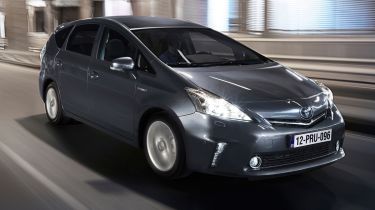Toyota Prius+
Massive-selling hybrid gets an added dose of practicality with a pair of extra seats at the rear

The Prius+ does exactly what is says on the tin, by offering everything the standard Prius does, plus a little bit more. With three rows of seats, loads of storage space and a panoramic roof, it’s a great way of transporting the whole family. The handling is far from sporty, but who cares when you’re comfortable and using so little fuel?
For the first six months of 2012, the Prius was third in the global sales chart, trailing only Ford’s Focus and Toyota’s Corolla.
It’s been a meteoric rise for the Prius since it launched 15 years ago, and Toyota’s dominance of the hybrid market looks set to continue with the Prius+. It’s Europe’s first hybrid seven-seater and the only full-size MPV to emit less than 100g/km of CO2, making it road-tax-free.
Toyota is keen to stress that this is a whole new vehicle from the ground up, not just a swollen version of the standard car.
Measuring 155mm longer, 30mm wider and 85mm higher, with a wheelbase extended by 80mm, the Prius+ is substantially larger, but the overall look is familiar. The front end gets a much wider, lower grille with sharp corners either side to improve airflow, while a roof spoiler reduces drag at the rear. It’s the higher, elongated roof that catches your eye, though, giving the car a classic MPV silhouette.
Used - available now

2024 Audi
A3 Sportback
50,864 milesAutomaticPetrol1.4L
Cash £23,497
2018 Peugeot
3008
35,735 milesManualDiesel1.6L
Cash £11,799
2022 BMW
X1
46,610 milesAutomaticPetrol2.0L
Cash £19,697
2023 Ford
Fiesta
12,239 milesManualPetrol1.0L
Cash £14,397Toyota has capitalised on the extra interior space by cramming in three rows of seats, each mounted 45mm higher than the row in front, for a stadium view of the road ahead. Headroom and legroom are generous, even in the back row, which can comfortably fit a couple of adults.
With all the seats occupied, there’s 200 litres of boot space. Fold the back row flat into the floor and that increases to 505 litres, and with the second row forward, there’s 1,750 litres to play with. An extra storage tray under the boot floor is handy, while the tailgate opening is 95mm wider than the Prius’, making larger objects easier to load.
An all-new dash design features a more upright centre stack, with a large rotary dial for controlling the air-conditioning, a trademark miniature gearlever and the electronic parking brake. The centre console is reserved for a cup-holder, storage bin and buttons for the three driving modes – EV, Eco and Power. The materials feel robust and functional, but nothing special.
This is the first Prius model – besides the plug-in Prius, which launches in the UK this summer – to use lithium-ion batteries, instead of a bulkier nickel-metal hydride pack. The switch isn’t just about saving weight, either – the batteries slot neatly under the centre console, between the driver and passenger, so there’s no compromise to interior space.
Besides the uprated batteries, the powertrain is identical to the smaller Prius’, and combines a 1.8-litre 98bhp petrol engine with an electric motor for a total of 134bhp. In T4 spec, it emits only 96g/km (better equipped T Spirit models emit 101g/km) – amazing, considering it weighs 75kg more than the standard Prius.
Performance is adequate, but the CVT gearbox makes an awful whine if you push the throttle hard. It’s better to cruise gently, sipping fuel and enjoying the supple ride and good refinement. You wouldn’t call the cheaper T4, which costs £2,840 more than the equivalent Prius, an entry-level model. It has plenty of standard kit, such as a head-up display, panoramic roof and a reversing camera. Pay another £3,300 for the T Spirit and you get leather, sat-nav and 17-inch wheels.






